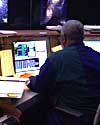
|
April
20, 11 a.m.
PDT
Getting Time on the Telescope
How
much time does an astronomer need to get that great
picture? We'll talk with scientists about how they
determine their experiments, and learn what it takes
to make their case for a few minutes of the telescope's
time.
Preshow "warm-up" webcast

|
|
Webcast
duration: 1 hour
An
archived version will be available one hour after
the end of the Webcast.
|
|

|
 Today's
Guest :
Today's
Guest :
Dr.
Melissa A. McGrath,
STSci Associate Astronomer
Melissa
McGrath specializes in research on the atmospheres, satellites
and magnetospheres of the gas-giant planets in our solar
system, and has recently begun working in the field of extra-solar
planet research. She used her time with Hubble to look at
Io, one of Jupiter's moons. Dr. McGrath is also an instrument
scientists working on the Cosmic Origins Spectrograph, a
new instrument to be installed on HST in 2003.
Above,
is Dr. McGrath's favorite HST image.
This
is an image of Io taken while the moon is in front of Jupiter.
You can see a little volcanic plume on the left side of
Io, the first time a plume on Io has ever been observed
from Earth. (They have been observed by spacecraft near
Io, but never before from Earth.)
|
![]()
![]()